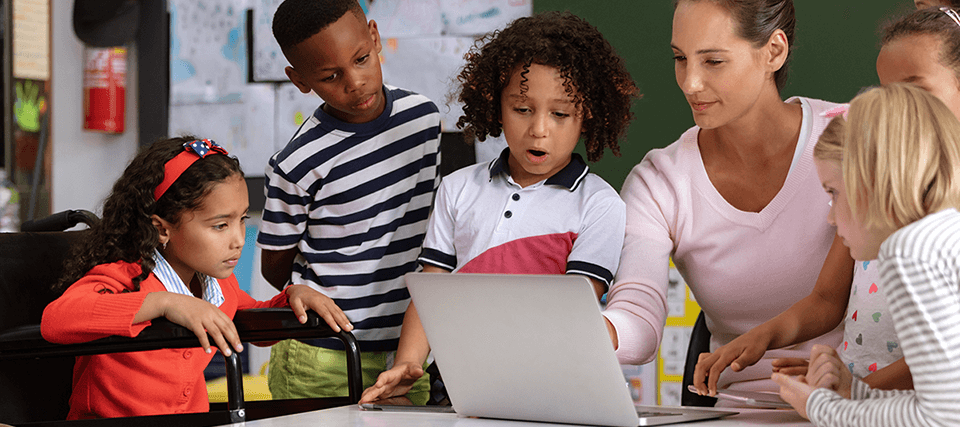Collaboration and Learning in a CS Classroom
There are many barriers to reaching the goal of “CSforAll.” Computer Science is a goal, but not a priority for many school administrators and principals. Lack of understanding and familiarity with computer science, pressure to handle tested curricula, and a lack of resources and teachers make the challenge of CSforAll difficult1.
Research has shown that achieving equity in computer science classes is not just about the material resources, but also the classroom environment2. A major goal of the CSforAll movement is to identify classroom practices that may broaden participation among students from groups who are underrepresented in computer science, such as women and racial minorities.
Collaborative learning is one such classroom practice. Collaborative learning features classrooms that are active, social, engaging, and student-owned. Research shows that these classrooms result in deeper learning. Research also shows that collaborative learning can help close achievement gaps3. However, the implementation of collaborative learning is currently still the exception. Students responding to questions from their teachers, by some accounts, only take up five percent of classroom time. Less than one percent of that time is associated with open-ended questions or responses4.
The main characteristics of collaborative learning are: a common task or activity; small group learning, co-operative behavior; interdependence; and individual responsibility and accountability. The interpersonal skills that can be acquired through collaborative learning can help all students acquire the identity as someone that can succeed within computer science, can help students provide one another with feedback, and can also help students nurture a respect for diverse options.
In classrooms that utilize collaborative learning, students are engaging with information along with their teacher and their peers. Engaging with information includes connecting new information with prior knowledge via a variety of methods such as reading, writing, discussing, explaining, and problem-solving. Students are active participants, as opposed to passive recipients, in classrooms that feature active learning.
Collaborative learning also takes into account our increasing knowledge of the connection between our emotions and learning. Classrooms that feature supportive environments help students incorporate, use, and recall information5. This is especially true for those students who come to our classrooms with social or emotional challenges5 - the exact population of students that are normally left out of computer science classrooms.
As educators, we shouldn't assume that our students come to our computer science classrooms divorced from their culture, place, and history6. We shouldn’t assume that when a student walks into a classroom or a computer lab that they are thinking and experiencing the same thing that we would be. Many students won’t understand or appreciate what computer science can do for them. For a myriad of reasons, students cannot grasp the opportunity that computer science presents to them. In order for CSforAll to be realized, teachers need to focus not just on what students are learning and the tools they are learning with, but also the classroom environment that can optimize student learning.
Creating a Classroom of Collaboration
When utilizing collaboration in a classroom, it is important to ensure that students’ activities are embedded within an authentic context. This is one of the main benefits of teaching computer science within a STEM context - computer science can be used to solve real-world problems. Classroom collaboration should not be the result of compliance but instead as a direct result of the task itself. The task design is essential to effective student collaboration. In robotics activities, for example, students are prompted to participate, stay on task, or share tasks equally. The critical consideration is the robustness of the activity, which you can analyze by asking yourself questions like the following.
-
Will students view the activity as being engaging and fun?
-
Is the activity robust enough that all students will have an active role?
-
Does the activity have clear directions and outcomes?
-
Does the activity allow for multiple solutions?
-
Does the activity account for different student interests?
Not all activities can reach each of these goals, but the more robustness incorporated into activities, the more of these engagement boxes you can check, the better. Therefore, the design of the activity that involves group work is important. Here are some other ideas for getting the most out of group work.
- Teach collaborative problem solving: Communication needs to be taught and reinforced for students to do it well. Here are some skills to teach your students.
- Listen actively—Don’t interrupt when someone is talking. Instead, give your full attention by sitting up, leaning forward, and nodding your head to acknowledge the speaker.
- Ask questions—If you’re unsure of an idea from a classmate, repeat what you think they meant or are suggesting. Don’t just say, “I’m not sure what you mean.”
- Disagree productively—Eventually, the team may need to come to a compromise or vote on a strategy. That’s OK because productively disagreeing can lead to wonderful ideas. This kind of disagreement often happens in the workplace. Use a calm voice when trying to decide on whose idea to use.
- Spend a few minutes at the end of each class recognizing examples of active listening, asking questions, and disagreeing productively.
- Teach persistence: Persistence is a valuable skill for school and life. Documenting persistence is an essential way to reinforce the practice of persistence with your students while emphasizing it as a shared value in your classroom and school.
- Provide structure: Make sure students understand what success means for the activity and the rules they need to follow to achieve that success. Don’t assume that students will understand. Model effective group communication and procedures, using formative assessment, such as an exit ticket, to make sure students understand the rules and having them explain to you what success for the project means.
A highly engaged classroom with motivated students leads to better learning outcomes and productive teachers and students.
